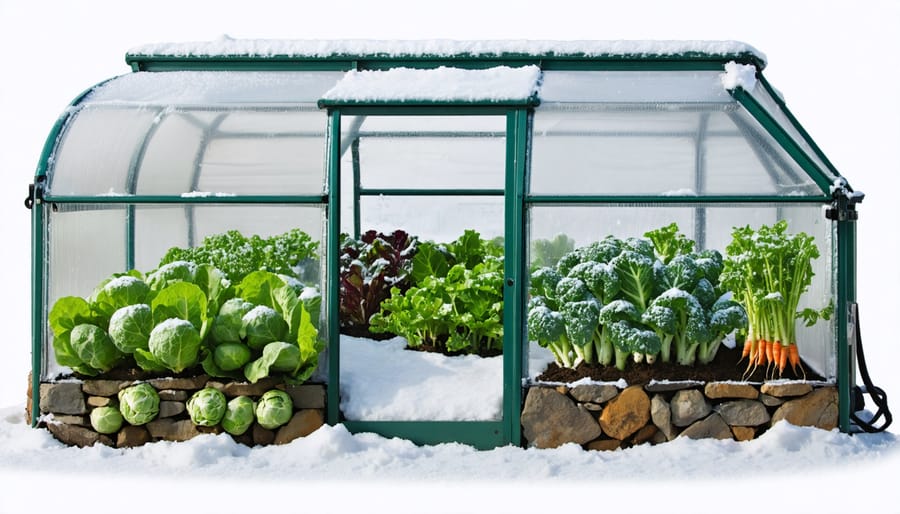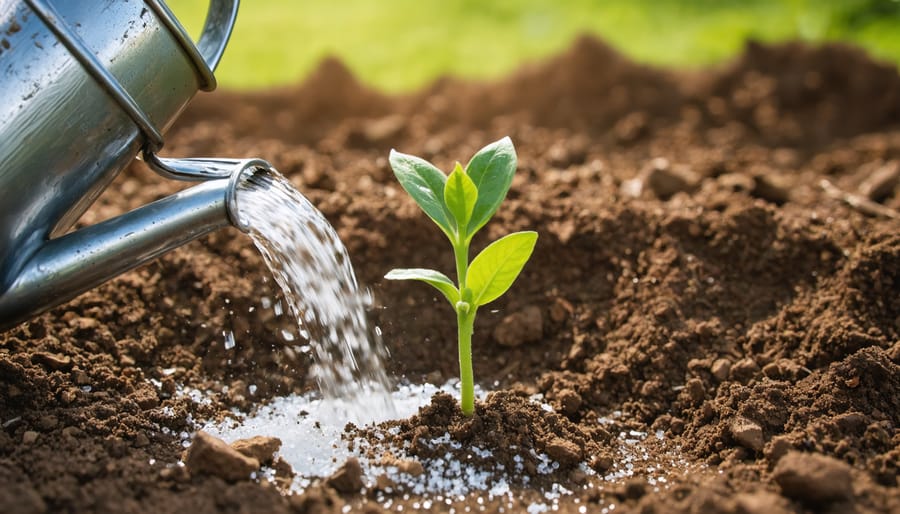Transform your cold-climate garden into a year-round food production system by extending growing seasons with sturdy hoop houses, selecting cold-hardy crop varieties, and implementing strategic succession planting. Despite increasingly unpredictable weather patterns, maintaining a productive garden throughout all four seasons demands less effort than many assume. Layer protective row covers inside greenhouses to create multiple temperature zones, allowing tender greens to thrive even during deep winter. Plant cold-tolerant varieties like kale, Brussels sprouts, and winter carrots in late summer for harvest through winter, while starting heat-loving crops indoors during February and March. Maximize growing space with vertical gardening techniques and thermal mass solutions—water-filled barrels and stone walls store daytime heat, releasing it slowly overnight to protect sensitive plants. Integrate season extension tools progressively, testing methods on a small scale before expanding, and track local frost dates and microclimates to optimize planting schedules. This systematic approach transforms the traditional growing calendar into a continuous cycle of planting, harvesting, and soil building that produces fresh, homegrown food every month of the year.
Planning Your Year-Round Garden Strategy
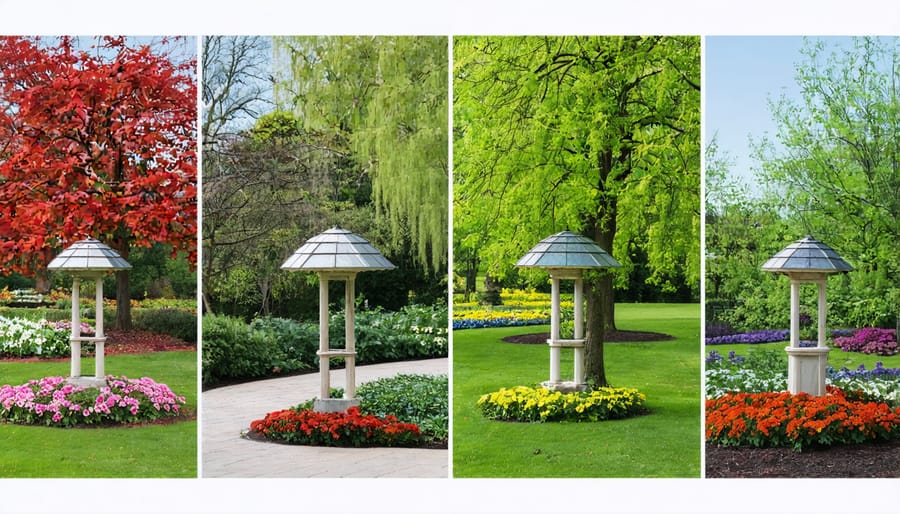
Understanding Your Local Climate Patterns
Success in year-round cold climate gardening starts with understanding your local climate patterns. Start by gathering historical weather data from nearby weather stations or agricultural extension offices. Pay special attention to your area’s first and last frost dates, but remember that these are averages – it’s wise to plan for a wider window of frost possibility.
Keep a garden journal to track weather patterns specific to your property. Note when frosts typically occur, where snow tends to pile up, and which areas thaw first in spring. This personal data becomes invaluable for planning your growing calendar.
Your yard likely contains several microclimates – small areas with distinct growing conditions. South-facing walls absorb heat during the day and release it at night, creating perfect spots for cold-sensitive plants. Dense shrubs or fences can block harsh winds, while low-lying areas might be prone to frost pockets. Take advantage of these natural features when planning your garden layout.
Consider investing in simple tools like a soil thermometer and min-max thermometer to monitor ground and air temperatures. These readings help you make informed decisions about when to plant, protect, or harvest your crops. Remember that modern climate variability means staying flexible and adapting your gardening schedule based on current conditions rather than strictly following traditional planting calendars.
Creating a Flexible Planting Calendar
A successful year-round garden starts with a well-planned planting calendar that can flex with nature’s unpredictable rhythms. Rather than following rigid dates, create a calendar that adapts to weather variations while maintaining your garden’s productivity throughout the seasons.
Begin by dividing your year into growing windows rather than specific dates. For example, early spring might span from “last frost plus two weeks” rather than a fixed date like March 15. This flexibility allows you to adjust your planting schedule based on real-time conditions while keeping your overall plan on track.
Keep detailed notes about your local climate patterns, including frost dates, rainfall, and temperature trends. These records become invaluable for future planning and help you spot patterns specific to your microclimate. Consider creating overlapping planting schedules where cool-season crops are started indoors while winter vegetables are still producing.
Use a simple spreadsheet or garden journal to track three key timeframes for each crop:
– Ideal planting window
– Expected harvest period
– Succession planting opportunities
Remember to build in buffer zones for unexpected cold snaps or late springs. For instance, have row covers ready and extra seedlings as backup. This approach ensures your garden remains productive even when Mother Nature throws a curveball, making year-round growing in cold climates not just possible, but reliable.
Essential Infrastructure for Cold Climate Success
Cold Frames and Hoop Houses
Cold frames and hoop houses are game-changers for cold climate gardening, offering affordable and effective ways to extend your growing season. Think of them as mini-greenhouses that protect your plants from harsh weather while capturing the sun’s warmth.
Cold frames are simple structures consisting of a wooden or concrete base with a transparent lid that opens for ventilation. They work wonderfully for starting seedlings early in spring and protecting cold-hardy vegetables throughout winter. Many gardeners create DIY cold frames using old windows or clear polycarbonate sheets, positioning them against south-facing walls for maximum heat absorption.
Hoop houses, also known as low tunnels, offer more growing space and flexibility. Created by bending flexible PVC pipes or metal conduit into half-circles over garden beds, then covering them with greenhouse plastic or row cover fabric, these structures can protect entire rows of plants. During sunny winter days, temperatures inside can rise 20-30 degrees higher than outside, creating a cozy microclimate for your crops.
For best results, monitor the temperature inside these structures daily. On warm days, ventilation is crucial to prevent overheating. Adding thermal mass, like water-filled containers or dark-colored stones, helps maintain steady temperatures overnight. Both structures work best when combined with cold-hardy plant varieties and proper timing of plantings.
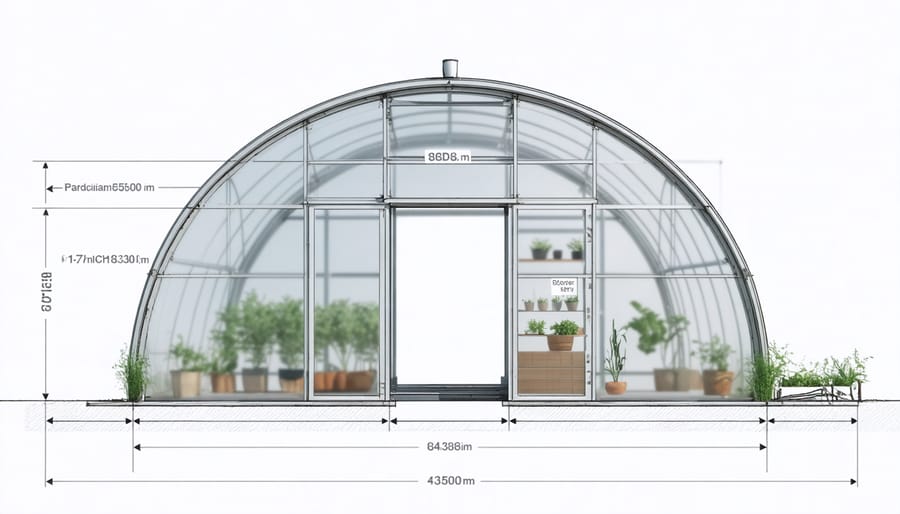
Greenhouse Options and Management
Greenhouses are game-changers for cold climate gardening, and there are several options to suit different needs and budgets. The most basic choice is a portable hoop house, which uses PVC pipes covered with greenhouse plastic – perfect for beginners and small spaces. For a more permanent solution, polycarbonate greenhouses offer excellent insulation and durability, though they require a bigger investment.
Lean-to greenhouses that attach to existing structures are ideal for maximizing heat retention and saving space. These benefit from the thermal mass of your home’s wall and typically cost less than freestanding structures. For serious year-round growers, heated greenhouses with automated ventilation systems provide the most control over growing conditions.
Regardless of the type you choose, proper management is crucial. Daily ventilation prevents humidity build-up and reduces disease risk. Installing shade cloth in summer and adding insulation in winter helps maintain optimal temperatures. Consider using thermal mass elements like water barrels or stone pathways to store heat during the day and release it at night.
Regular maintenance includes checking for damage, cleaning panels to maximize light transmission, and ensuring proper drainage. Many gardeners find that combining a greenhouse with cold frames or row covers creates a versatile system for extending the growing season while managing costs and space efficiently.
Smart Temperature Management Systems
Modern technology has revolutionized cold-climate gardening, making it easier than ever to maintain ideal growing conditions throughout the year. Smart temperature management systems combine sensors, automated controls, and mobile connectivity to help gardeners monitor and adjust their growing environment with precision.
At the heart of these systems are digital thermostats and humidity sensors that provide real-time data about your growing space. These can be connected to ventilation fans, heating systems, and automated window openers that respond to environmental changes. Many gardeners find that setting up a simple smart controller with their heating cables or greenhouse fans can save hours of manual adjustments while protecting their plants from sudden temperature swings.
For those just starting out, basic WiFi-enabled thermometers can send alerts to your phone when temperatures drop too low or climb too high. This early warning system is particularly valuable during spring and fall when nighttime temperatures can be unpredictable. More advanced systems might include soil temperature probes, automated irrigation controls, and even artificial lighting that adjusts based on available natural light.
One of the most practical innovations is zone-specific heating, which allows you to maintain different temperature zones within the same growing space. This means you can grow cool-season crops alongside warmth-loving plants, maximizing your garden’s productivity while minimizing energy costs.
Remember that technology should complement, not replace, good gardening practices. The most successful systems combine modern conveniences with traditional knowledge and careful observation.
Crop Selection and Timing
Cold-Hardy Vegetables for Winter Growing
Winter gardening doesn’t mean your veggie patch has to hibernate! Many vegetables actually thrive in cooler temperatures, and some even develop sweeter flavors after a light frost. Kale is a superstar winter crop, with varieties like ‘Winterbor’ and ‘Red Russian’ standing strong against freezing temperatures. These hardy greens become sweeter as temperatures drop, making them perfect for soups and salads.
Root vegetables are excellent cold-weather performers. Carrots, particularly varieties like ‘Napoli’ and ‘Merida,’ can withstand temperatures well below freezing when properly mulched. Parsnips and turnips also excel in winter gardens, developing complex, sweet flavors that make them winter kitchen favorites.
Brussels sprouts and cabbage are classic winter vegetables that actually prefer cold weather. The ‘January King’ cabbage variety is particularly resilient, while ‘Diablo’ Brussels sprouts can handle temperatures down to 0°F (-18°C). For quick winter harvests, consider fast-growing Asian greens like pak choi and tatsoi, which mature in just 45-50 days.
Spinach deserves special mention, with varieties like ‘Winter Bloomsdale’ and ‘Giant Winter’ providing fresh greens throughout the cold months. These hardy plants often survive winter under snow cover and resume growth in early spring. Don’t forget about garlic – planted in fall, it develops strong roots during winter and emerges ready to grow in spring.
For best results, choose varieties specifically bred for winter growing. Many seed companies now offer specialized “winter garden” collections that take the guesswork out of selection. Remember to plant these crops at the right time – typically late summer to early fall – so they’re well-established before severe cold hits.
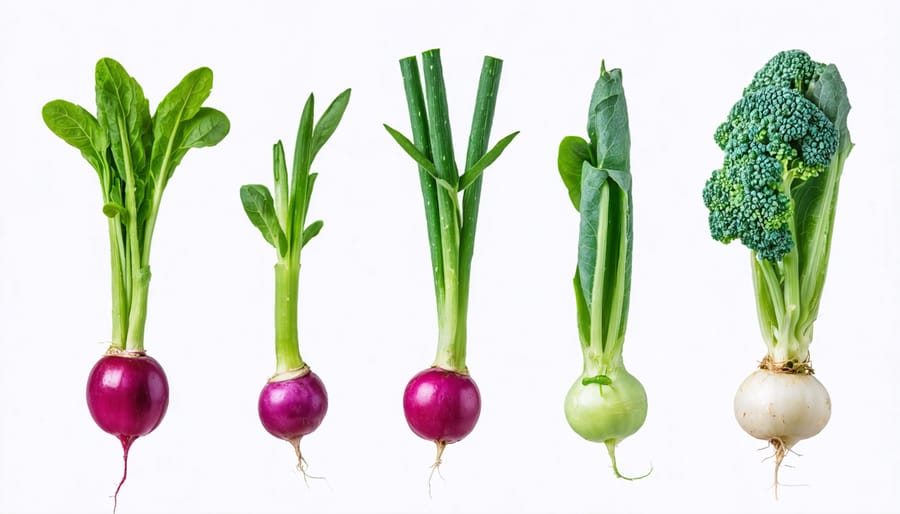
Succession Planting Strategies
Succession planting is your secret weapon for maintaining a steady harvest throughout the growing season, even in cold climates. Instead of planting everything at once, stagger your plantings every 2-3 weeks to ensure continuous production. This strategy works particularly well with quick-growing crops like lettuce, radishes, and spinach.
Start by dividing your garden into sections and creating a detailed planting calendar. For example, plant your first round of carrots in early spring, then sow another batch two weeks later. By the time you harvest the first crop, the second will be nearly ready. This approach not only provides fresh vegetables consistently but also helps manage your garden workload.
Consider using the “relay planting” technique, where you plant cold-hardy crops like peas in early spring, then plant heat-loving crops like tomatoes in the same spot once the peas finish. This maximizes your growing space and extends your harvest season.
For winter harvests, start planning in mid-summer. Plant cold-tolerant varieties like kale and Brussels sprouts that can withstand frost and actually become sweeter after exposure to cold temperatures. Time these plantings so they reach maturity just as winter approaches.
Keep detailed notes of what works best in your specific climate. Some vegetables might need longer growing times than listed on seed packets, while others might perform better with certain timing adjustments. Remember to factor in your first and last frost dates when planning your succession schedule, and always have row covers or cold frames ready to protect tender plants when temperatures drop unexpectedly.
Quick-Growing Crops for Weather Windows
Making the most of weather windows is crucial for cold climate gardening success. These brief periods of favorable conditions between weather events can be perfect opportunities to grow quick-maturing crops. By choosing the right varieties and timing your plantings strategically, you can maximize your garden’s productivity even in challenging climates.
Leafy greens are your best friends for these short growing windows. Arugula can be ready to harvest in as little as 21 days, while leaf lettuce varieties typically mature in 30-45 days. Baby spinach can be harvested just 25-30 days after planting, making it perfect for those brief warm spells.
Radishes are another excellent choice, often maturing in just 20-30 days. Fast-growing Asian greens like tatsoi and mizuna can be ready in 21-30 days, adding variety to your quick-crop rotation. Bush beans can produce harvestable pods in about 50-55 days, while baby carrots can be pulled in around 30 days for tender finger-sized treats.
To make the most of these opportunities:
– Keep seed packets ready and soil prepared
– Watch weather forecasts carefully
– Use row covers or cold frames to extend growing windows
– Succession plant every 7-10 days during favorable periods
– Choose “baby” varieties that mature quickly
– Consider microgreens for ultra-quick results (ready in 7-14 days)
Remember to maintain consistent moisture for these fast-growing crops, as they’ll need reliable water to develop quickly. Many of these plants can also be started indoors and transplanted out when conditions improve, giving you a head start on the growing season.
By staying flexible and ready to plant when conditions allow, you can take advantage of even brief favorable periods to grow fresh, homegrown produce throughout the growing season.
Weather Protection Techniques
Emergency Weather Response Plans
When severe weather strikes, quick action can save your garden from devastation. Keep row covers, old blankets, and plastic sheeting readily available for emergency protection. During sudden frost warnings, cover tender plants before sunset and remove covers in the morning once temperatures rise above freezing.
For hail protection, create simple protective structures using PVC hoops or overturned buckets and baskets. If high winds are forecast, temporarily stake tall plants and move container gardens to sheltered locations. Consider installing a basic weather alert system on your phone to receive timely warnings.
Heavy snow requires immediate attention – gently brush off accumulation from greenhouse roofs and protected structures before weight becomes an issue. For ice storms, avoid disturbing frozen plants as this can cause more damage. Instead, wait for natural thawing.
Keep an emergency kit with essential supplies: plant stakes, twine, frost cloth, repair tape for greenhouse covers, and spare cloche materials. Remember, preparation is key – check weather forecasts daily during volatile seasons and have your protection plan ready to implement at a moment’s notice.
Multi-Layer Protection Systems
Creating a robust defense against cold weather involves layering multiple protection methods, much like wearing layers of clothing in winter. Start with a sturdy cold frame or hoop house as your foundation, then add row covers inside for an extra barrier. Place water-filled containers near your plants to absorb heat during the day and release it at night, creating a microclimate that helps stabilize temperatures.
Consider using thermal mass materials like stone or brick along the north side of your growing space to capture and retain heat. Combine this with heavy mulching around plants using straw, leaves, or wood chips. For especially tender plants, individual cloches can be placed under the larger protection systems, creating a triple-layer shield against frost.
Adding windbreaks around your garden’s perimeter helps maintain warmer temperatures inside your protected growing space. Some gardeners even use holiday lights or heating cables beneath row covers for additional warmth during extreme cold snaps. Remember to monitor temperatures within your layered system and adjust ventilation as needed to prevent overheating on sunny days.
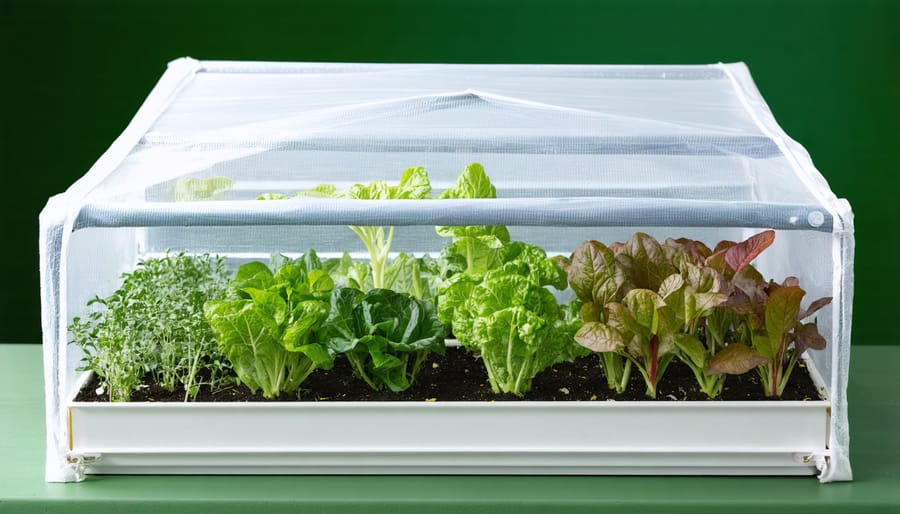
Year-round gardening in cold climates may seem daunting at first, but with the right combination of planning, protection, and plant selection, you can create a thriving garden that produces throughout all seasons. Even in a challenging garden space, success is achievable when you implement the strategies we’ve discussed.
Remember to start small and gradually expand your year-round growing operation. Begin with cold frames or a simple hoop house, then experiment with different cold-hardy varieties. Pay attention to your specific microclimate and learn from each season’s experiences. Succession planting, proper timing, and maintaining good soil health will become second nature with practice.
The rewards of year-round gardening extend beyond fresh produce – you’ll develop a deeper connection with nature’s cycles and gain satisfaction from growing food in all seasons. Don’t let cold weather discourage you; instead, view it as an opportunity to expand your gardening expertise. Start planning your four-season garden today, and join the growing community of year-round gardeners who prove that with dedication and the right approach, every season can be growing season.

